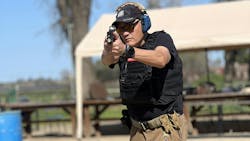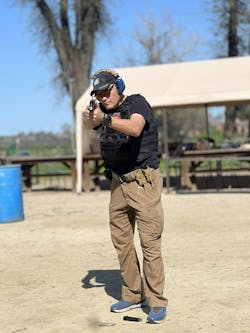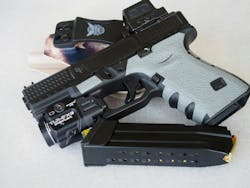My New Everyday Carry: How the Change Improves My Setup
What to know
- Switching to a Glock 19 with Holosun 509 optics, a Streamlight TLR 8X light and Mec-Gar magazines for everyday carry (EDC) improved speed, accuracy and reliability over traditional iron-sight setups.
- The Safariland 7360RDS holster has Level III retention, optic/light compatibility and intuitive draw, supporting seamless force transitions.
- Trends in body camera footage and personal training show optics and lights enhance performance under stress, reinforcing the value of modernized duty gear.
I've been carrying a Glock 19, with a Holosun 509 optic, Mec-Gar Magazines, and a Streamlight TLR 8X as my EDC setup. Anyone who knows me, knows that this is an unusual change in behavior. I generally carry “naked” guns, meaning I shoot iron sights and rarely use dedicated lights. What shifted my paradigm? This new setup is faster, and it’s easy to prove.
In my career, I have looked at gunfight statistics, gunfight breakdowns, and talked to officers who have experience in this area. Years ago, our firearms focus was based on the “Rule of 3’s.” That is, early FBI statistics pointed to the “typical” law enforcement firearms usage as mostly within 3 yards, lasting fewer than 3 seconds, and around 3 rounds expended.
Rather than diving into the source of this logic and statistics, it’s much better to look at the pool of shooting statistics that are outside these numbers. It is enough to articulate that the outliers-longer engagement distances, more rounds expended, or longer durations, are significant enough to justify our training and equipment. In simpler terms, the person who believes that they shouldn’t train for other scenarios or use these numbers to justify not using sighted fire and good optics, is a fool.
Recently, I have been helping on the range, which serves local recruits. We have a very competent range instructional team, who train and work together. They are such a well-oiled machine, I am gen - erally relegated to RSO duties, rather than teaching duties.
For our range uniform, we issue the Safariland 7360RDS. The Safariland 7360RDS 7TS is a Level III holster designed for an optic mounted gun with a dedicated light.
We use Glock 17s because many of our local agencies use them. Since our recruits will likely use them when they go to their agencies, we went with Glocks. I prefer a Glock 19, so I opted for one for teaching. One of the largest agencies in the area adopted the Holosun 509 system, we mounted them on our academy guns. We added a mounted light.
I was trying to simplify things. I wanted to go from range duty to off duty using the same gun. This may have a little to do with the fact that we sometimes use the range attached to the local prison. I try not to leave anything in my car while training, for obvious reasons.
Safariland 7360 RDS
The Safariland 7360 RDS is a Level III mid-ride holster designed to fit and protect weapons with red dot optics. It has the Automatic Locking System protection, which locks the gun when re-holstering, and adds an additional level with the rear strap. Deploying the gun is instinctive and simple with natural thumb motions.
I think the best use case scenario for the Safariland 7360 RDS is force transition. Changing from a drawn gun to other force options is a matter of just dropping the gun in the holster. Most officers can quickly activate the SLS (self-locking system) and have the extra level of protection from an assailant’s attempted takeaway.
I picked the straight draw and instinctive operation of the Safariland 7360 RDS for my duty gun. Not that I really care, but it does protect the finish of my Glock, with the non-abrasive SafariSeven material. The important aspect is the design that includes internal raised surfaces, which let dust and moisture to clear the holster. The draw is consistent, even in the rain.
Holosun HE509 LED
The Holosun HE509 LED Sight is one of the fastest tools for law enforcement use. It is a fully enclosed RDS with a nitrogen purged titanium housing. The battery has up to 50k hours of life, and it has a Solar Failsafe. The Shake Awake technology ensures the reticle is always on when you need it.
Offered in either red or green, the Circle Dot is my favorite reticle on an optic. This is a 32 MOA circle and a 2 MOA dot. The circle has horizontal and vertical stadia lines. The eyes pick up this reticle so quickly, I can out shoot my own chunky iron sights with it. At ranges beyond 15 yards, I can align the 2 MOA dot on a target with great precision.
I have several RDS setups. The Holosun 509 is the one I picked for my EDC. I have run thousands of rounds with mine. The Solar Failsafe always gives the correct intensity. It doesn’t fog, is easy to maintain, and changing the battery (which can last for years) does not change the settings. I hammered my Holosun around the range for over a year before adding it to my kit. I’m on team Holosun now.
Mec-Gar Magazines
I never even considered non-Glock magazines until I started slamming Mec-Gar Magazines into my mag wells. When I handled these magazines, I found how slick the body was. The heat treated carbon steel looks like it was made with one piece, or at least the welds are completely invisible. When I looked at the notch for the magazine catch, it was a bit more radiused than my standard Glock magazines. The Mec-Gar magazines seated better, and stayed in the well without any rattle. Although the difference is in milliseconds, the Mec-Gar magazines felt better and seemed to operate faster.
The Glock 19 Mec-Gar magazine holds 18 rounds. It was the same size as the G17 magazines, except the G19 one has a shrouded hi impact polymer floorplate extension.
The best feature of the Mec-Gar Glock magazine is the smoothness in loading. They use a high impact polymer follower and music wire springs. Most magazines have a noticeable “stacking” as the spring compresses. One doesn’t notice this until pushing in the 18th round.
I was testing these magazines by cranking out boxes of rounds on my Dillon XL 750 and sending them down range. Before I started carrying Mec-Gar as my EDC, I dropped them on the range floor for reloads dozens of times, ran all kinds of ammo through them, and practiced reloads hundreds of times. I liked the hi-vis green follower, which completely eliminates “nose-diving.” I love the way these mags drop free from my Glock.
Glock 19 GEN 3
My GEN 3 Glock 19 weighs 23.63 oz unloaded. I have had it for years. I added a Swampfox Wolverine slide to accommodate the Holosun. I like to keep my off duty carry options under 21 oz, but on duty guns should have a larger frame and a little more weight. The full weight of this combo is right between on and off duty.
The Glock 19 is the perfect size for officers who could potentially be assigned Patrol or special assignments without a lot of notice. It is small enough for discreet carry, and large enough for uniform wear.
In the past few years, Agencies have decreased the time from incident to bodycam public release. I regularly review these vids. What I have seen lately is a trend toward a consistent shooting cadence accurate delivery. This suggests two things: Optics on handguns generally have improved accuracy and individual officers seem to be doing effective training. This is a comment on force response, not force decision, but force decision-making is looking up also. It is professionalism that is driving this trend, so I encourage our Brothers and Sisters in Blue to keep it up.
When I settle in for a training session, I like to do failure drills. It is a simple response: Two to the body, assess, and one to the head. Using this drill, I mix it up. I vary the distance, shooting position, target, and rounds expended. While we always train to engage with both eyes open, the optic allows for target and sighting device simultaneously, simply because a reticle is overlaid on the target. In the dynamic scenario of an actual encounter, the optic equipped gun with the mounted light may give a slight edge.
Streamlight TLR 8X
The truth is, I have been resistant toward adding a dedicated light to a handgun for years. To be clear, I had one for my Glock when they first became popular in the 90’s, but only actually mounted one for certain applications. For instance, once I had to crawl under a building after a suspect went into a crawl space. I couldn’t crawl, hold a light and a gun at the same time.
As the products progressed, I kept experimenting with improved mounts, smaller and brighter lights, and other subtle improvements. The Streamlight TLR 8X design finally convinced me. The paddle switches clinched the deal. The switches are tiny appendages that sit on either side the rear of the device. They are out of the way, but I can access them with my non-shooting thumb or my trigger finger. My training philosophy says that the trigger finger is only for the trigger, so I’ll probably only use my thumb to fire the light.
Holding the paddle switches down makes them momentary switches. Just flicking them leaves the LED on. I thought that this arrangement would be counterintuitive, until I began practicing building searches. I got to the point where I could handle the TLR 8X instinctively.
The TLR 8X even has a lockout switch, where one turns the bezel until one can feel the detent. The system stays off for training. This lets the user run it for range practice without using up the battery.
The laser is visible down range in bright daylight. I picked the green version to offset the red reticle I was running. This is an excellent choice for the officer who occasionally uses a ballistic shield. The green dot is sufficient for guiding the bullet with precision. The TLR 8X is dual fueled. It is bright enough for any kind of search.
My range instruction set up has become my EDC. I should probably mention that major holster manufacturers may not have caught up with guns mounted with the Streamlight TLR 8X. Some designs allow for the Glock 19 with a TLR 7A. Your mileage may vary.
About the Author

Officer Lindsey Bertomen (ret.), Contributing Editor
Lindsey Bertomen is a retired police officer and retired military small arms trainer. He teaches criminal justice at Hartnell College in Salinas, California, where serves as a POST administrator and firearms instructor. He also teaches civilian firearms classes, enjoys fly fishing, martial arts, and mountain biking. His articles have appeared in print and online for over two decades.



